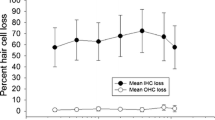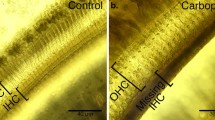Abstract
The relationship between the middle ear acoustic reflex (AR) and inner hair cell (IHC) loss is currently unknown. Given that IHC are believed to convey nearly all acoustic information to the central auditory nervous system, it has been assumed that loss of IHC would significantly impact the AR. To evaluate this relationship, we assessed the presence and amplitude of the AR in chinchillas before and after treatment with carboplatin, an anticancer drug that reliably and selectively destroys IHC in this species. Baseline measures of hearing sensitivity, including auditory brainstem response (ABR) thresholds and distortion product otoacoustic emissions (DPOAE), were assessed and then re-evaluated following carboplatin treatment. Post-carboplatin ABR thresholds and DPOAE were found to be unchanged or slightly elevated; results were consistent with published reports. Our main hypothesis was that loss of IHC would abolish the reflex or significantly reduce its amplitude. Contrary to our hypothesis, the ipsilateral 226-Hz AR continued to be reliably elicited following carboplatin treatment. Post-mortem histological analysis confirmed significant IHC loss (65–85 %), but no measurable loss of outer hair cells (OHCs). Given that loss of IHC alone does not significantly reduce the 226-Hz AR, our results suggest that few IHC are needed to maintain the 226-Hz AR response. These results suggest additional studies are needed to better understand the role of IHC in the reflex arc, present opportunities to further study the reflex pathway, and could change how we use the clinical AR as a potential diagnostic tool for IHC dysfunction, including those related to IHC synaptopathy.





Similar content being viewed by others
Abbreviations
- ABR:
-
Auditory brainstem response
- AR:
-
Acoustic reflex
- CANS:
-
Central auditory nervous system
- dB:
-
Decibel
- DPOAE:
-
Distortion product otoacoustic emissions
- HL:
-
Hearing level
- IHCs:
-
Inner hair cells
- MEMR:
-
Middle ear muscle response
- MOC:
-
Medial olivocochlear
- OHCs:
-
Outer hair cells
- SD :
-
Standard deviation
- SEM:
-
Standard error of the mean
- SPL:
-
Sound pressure level
References
Anderson H, Barr B, Wedenberg E (1969) Early diagnosis of 8th-nerve tumours by acoustic reflex tests. Acta Otolaryngol Suppl 263:232–237
Arslan HH, Edizer DT, Cebeci S, Erdal M (2014) Diagnostic utility of Stenger test: reappraisal of its value. Int Tinnitus J 19:57–62
Badri R, Siegel JH, Wright BA (2011) Auditory filter shapes and high-frequency hearing in adults who have impaired speech in noise performance despite clinically normal audiograms. J Acoust Soc Am 129:852–863
Bauch CD, Olsen WO, Harner SG (1983) Auditory brain-stem response and acoustic reflex test. Arch Otolaryngol 109:522–525
Bennett M (1984) Impedance concepts relating to the acoustic reflex. In: The acoustic reflex. basic principles and clinical applications. (Silman S, ed), pp 35–61. Orlando, FL: Academic Press, Inc
Bharadwaj HM, Mai AR, Simpson JM, Choi I, Heinz MG, Shinn-Cunningham BG (2019) Non-invasive assays of cochlear synaptopathy - candidates and considerations. Neuroscience
Bohne BA, Kenworthy A, Carr CD (1982) Density of myelinated nerve fibers in the chinchilla cochlea. J Acoust Soc Am 72:102–107
Borg E (1971) Efferent inhibition of afferent acoustic activity in the unanesthetized rabbit. Exp Neurol 31:301–312
Borg E, Counter SA, Rosler G (1984) Theories of middle-ear muscle functions. In: The acoustic reflex: basic principles and clinical applications. Orlando, FL.: Academic Press, Inc
Borg E, Engstrom B (1982) Acoustic reflex after experimental lesions to inner and outer hair cells. Hear Res 6:25–34
Borg E, Zakrisson JE (1974) Stapedius reflex and monaural masking. Acta Otolaryngol 78:155–161
Callan DE, Lasky RE, Fowler CG (1999) Neural networks applied to retrocochlear diagnosis. Journal of Speech, Language, and Hearing Research : JSLHR 42:287–299
Charaziak KK, Shera CA (2017) Compensating for ear-canal acoustics when measuring otoacoustic emissions. J Acoust Soc Am 141:515
de Swanepoel W, Werner S, Hugo R, Louw B, Owen R, Swanepoel A (2007) High frequency immittance for neonates: a normative study. Acta Otolaryngol 127:49–56
El-Badry MM, McFadden SL (2009) Evaluation of inner hair cell and nerve fiber loss as sufficient pathologies underlying auditory neuropathy. Hear Res 255:84–90
Emanuel DC, Henson OE, Knapp RR (2012) Survey of audiological immittance practices. Am J Audiol 21:60–75
Gelfand SA, Schwander T, Silman S (1990) Acoustic reflex thresholds in normal and cochlear-impaired ears: effects of no-response rates on 90th percentiles in a large sample. J Speech Hear Disord 55:198–205
Gerhardt KJ, Walton JP (1986) Binaural acoustic reflex activity following monaural noise exposure in decerebrate chinchillas. Audiology : Official Organ of the International Society of Audiology 25:309–320
Guest H, Munro KJ, Plack CJ (2019) Acoustic middle-ear-muscle-reflex thresholds in humans with normal audiograms: no relations to tinnitus, speech perception in noise, or noise exposure. Neuroscience 407:75–82
Guest H, Munro KJ, Prendergast G, Millman RE, Plack CJ (2018) Impaired speech perception in noise with a normal audiogram: no evidence for cochlear synaptopathy and no relation to lifetime noise exposure. Hear Res 364:142–151
Holte L, Margolis RH, Cavanaugh RM Jr (1991) Developmental changes in multifrequency tympanograms. Audiology : Official Organ of the International Society of Audiology 30:1–24
Hunter LL, Margolis RH (1992) Multifrequency tympanometry: current clinical application. Am J Audiol 1:33–43
Hunter LLS, N. (2014) Acoustic immittance measures: basic and advanced practice. Plural Publishing, San Diego, CA
Jerger J, Anthony L, Jerger S, Mauldin L (1974) Studies in impedance audiometry. 3. Middle Ear Disorders Archives of Otolaryngology 99:165–171
Jerger J, Jerger S, Mauldin L (1972) Studies in impedance audiometry. I. Normal and sensorineural ears. Arch Otolaryngol 96:513–523
Jerger S, Jerger J, Hall J (1979) A new acoustic reflex pattern. Arch Otolaryngol 105:24–28
Keefe DH, Fitzpatrick D, Liu YW, Sanford CA, Gorga MP (2010) Wideband acoustic-reflex test in a test battery to predict middle-ear dysfunction. Hear Res 263:52–65
Kiang NY, Rho JM, Northrop CC, Liberman MC, Ryugo DK (1982) Hair-cell innervation by spiral ganglion cells in adult cats. Science 217:175–177
Kobler JB, Guinan JJ Jr, Vacher SR, Norris BE (1992) Acoustic reflex frequency selectivity in single stapedius motoneurons of the cat. J Neurophysiol 68:807–817
Lobarinas E, Salvi R, Ding D (2013) Insensitivity of the audiogram to carboplatin induced inner hair cell loss in chinchillas. Hear Res 302:113–120
Lobarinas E, Salvi R, Ding D (2016) Selective inner hair cell dysfunction in chinchillas impairs hearing-in-noise in the absence of outer hair cell loss. J Assoc Res Otolaryngol 17:89–101
Lobarinas E, Salvi R, Ding D (2020) Gap detection deficits in chinchillas with selective carboplatin-induced inner hair cell loss. J Assoc Res Otolaryngol
Middelweerd MJ, Festen JM, Plomp R (1990) Difficulties with speech intelligibility in noise in spite of a normal pure-tone audiogram. Audiology : Official Organ of the International Society of Audiology 29:1–7
Moller AR (1974a) Responses of units in the cochlear nucleus to sinusoidally amplitude-modulated tones. Exp Neurol 45:105–117
Moller AR (1974b) The acoustic middle ear muscle reflex. Springer, Verlag, Berlin
Moller AR (1984) Neurophysiological basis of the acoustic middle-ear reflex. In: The acoustic reflex: basic principles and clinical applications. (Silman S, ed). Orlando, FL: Academic Press, Inc
Mukerji S, Windsor AM, Lee DJ (2010) Auditory brainstem circuits that mediate the middle ear muscle reflex. Trends Amplif 14:170–191
Muller M, Hoidis S, Smolders JW (2010) A physiological frequency-position map of the chinchilla cochlea. Hear Res 268:184–193
Olsen WO, Noffsinger D, Kurdziel S (1975) Acoustic reflex and reflex decay. Occurrence in patients with cochlear and eighth nerve lesions. Arch Otolaryngol 101:622–625
Pawlowski K, Koulich E, Wright CG, Roland P (2013) Ototopic applications of povidone iodine/dexamethasone in the rat. Otology & neurotology : official publication of the American Otological Society, American Neurotology Society [and] European Academy of Otology and Neurotology 34:167–174
Plack CJ, Barker D, Prendergast G (2014) Perceptual consequences of “hidden” hearing loss. Trends in Hearing 18
Prasher D, Cohen M (1993) Effectiveness of acoustic reflex threshold criteria in the diagnosis of retrocochlear pathology. Scand Audiol 22:11–18
Qiu C, Salvi R, Ding D, Burkard R (2000) Inner hair cell loss leads to enhanced response amplitudes in auditory cortex of unanesthetized chinchillas: evidence for increased system gain. Hear Res 139:153–171
Rosowski JJ, Ravicz ME, Songer JE (2006) Structures that contribute to middle-ear admittance in chinchilla. J Comp Physiol A Neuroethol Sens Neural Behav Physiol 192:1287–1311
Salvi R, Sun W, Ding D, Chen GD, Lobarinas E, Wang J, Radziwon K, Auerbach BD (2016) Inner hair cell loss disrupts hearing and cochlear function leading to sensory deprivation and enhanced central auditory gain. Front Neurosci 10:621
Salvi RJ, Ding D, Wang J, Jiang HY (2000b) A review of the effects of selective inner hair cell lesions on distortion product otoacoustic emissions, cochlear function and auditory evoked potentials. Noise Health 2:9–26
Salvi RJ, Wang J, Ding D (2000a) Auditory plasticity and hyperactivity following cochlear damage. Hear Res 147:261–274
Shaffer LA, Withnell RH, Dhar S, Lilly DJ, Goodman SS, Harmon KM (2003) Sources and mechanisms of DPOAE generation: implications for the prediction of auditory sensitivity. Ear Hear 24:367–379
Silman S, Gelfand SA (1981) The relationship between magnitude of hearing loss and acoustic reflex threshold levels. J Speech Hear Disord 46:312–316
Takeno S, Harrison RV, Mount RJ, Wake M, Harada Y (1994) Induction of selective inner hair cell damage by carboplatin. Scanning Microsc 8:97–106
Trautwein P, Hofstetter P, Wang J, Salvi R, Nostrant A (1996) Selective inner hair cell loss does not alter distortion product otoacoustic emissions. Hear Res 96:71–82
Trevino M, Lobarinas E, Maulden AC, Heinz MG (2019) The chinchilla animal model for hearing science and noise-induced hearing loss. J Acoust Soc Am 146:3710
Uhles ML, Clark WW, Anch M (2000) Effects of alcohol on the acoustic reflex threshold in the chinchilla. Acta Otolaryngol 120:523–528
Valero MD, Hancock KE, Liberman MC (2016) The middle ear muscle reflex in the diagnosis of cochlear neuropathy. Hear Res 332:29–38
Valero MD, Hancock KE, Maison SF, Liberman MC (2018) Effects of cochlear synaptopathy on middle-ear muscle reflexes in unanesthetized mice. Hear Res 363:109–118
Vrettakos PA, Dear SP, Saunders JC (1988) Middle ear structure in the chinchilla: a quantitative study. Am J Otolaryngol 9:58–67
Wake M, Anderson J, Takeno S, Mount RJ, Harrison RV (1996) Otoacoustic emission amplification after inner hair cell damage. Acta Otolaryngol 116:374–381
Wake M, Takeno S, Ibrahim D, Harrison R (1994) Selective inner hair cell ototoxicity induced by carboplatin. Laryngoscope 104:488–493
Wang X, Gan RZ (2016) 3D finite element model of the chinchilla ear for characterizing middle ear functions. Biomech Model Mechanobiol 15:1263–1277
Wersinger E, Fuchs PA (2011) Modulation of hair cell efferents. Hear Res 279:1–12
Wojtczak M, Beim JA, Oxenham AJ (2017) Weak middle-ear-muscle reflex in humans with noise-induced tinnitus and normal hearing may reflect cochlear synaptopathy. eNeuro 4
Woodford CM, Henderson D, Hamernik RP, Feldman AS (1976) Acoustic reflex threshold of the chinchilla as a function of stimulus duration and frequency. J Acoust Soc Am 59:1204–1207
Zhang KD, Coate TM (2017) Recent advances in the development and function of type II spiral ganglion neurons in the mammalian inner ear. Semin Cell Dev Biol 65:80–87
Funding
Research reported in this manuscript was supported by the NIDCD of the National Institutes of Health under award number R01DC014088.
Author information
Authors and Affiliations
Contributions
All authors contributed to data collection and writing of the manuscript.
Corresponding author
Ethics declarations
Disclaimer
The content is solely the responsibility of the authors and does not necessarily represent the official views of the National Institutes of Health.
Additional information
Publisher's Note
Springer Nature remains neutral with regard to jurisdictional claims in published maps and institutional affiliations.
Rights and permissions
About this article
Cite this article
Trevino, M., Escabi, C., Swanner, H. et al. No Reduction in the 226-Hz Probe Tone Acoustic Reflex Amplitude Following Severe Inner Hair Cell Loss in Chinchillas. JARO 23, 593–602 (2022). https://doi.org/10.1007/s10162-022-00861-3
Received:
Accepted:
Published:
Issue Date:
DOI: https://doi.org/10.1007/s10162-022-00861-3




